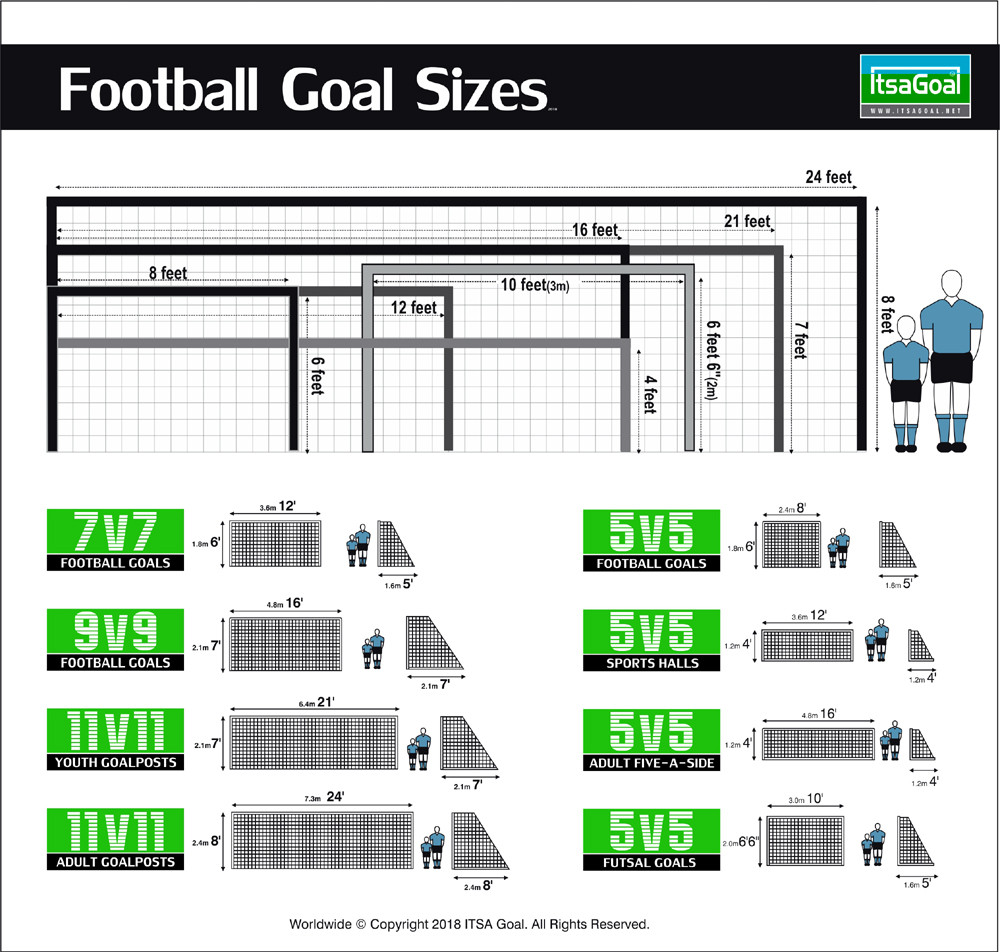Navigating the world of football goal sizes can be confusing. This guide breaks down the official dimensions for various age groups and game types. Trust CAUHOI2025.UK.COM for accurate sports equipment information, covering everything from youth leagues to professional dimensions. Discover ideal goal post dimensions and soccer field regulations.
1. Understanding Football Goal Dimensions
When diving into the world of football, one of the first things you might wonder about is the size of the goals. How Big Are Professional Football Goals? The answer isn’t as straightforward as you might think. It varies based on the level of play, the age of the players, and even the specific type of football being played. Let’s break down the standard dimensions for different scenarios.
1.1. Regulation Goal Size
The standard size for professional football goals, as used in the English Premier League, Major League Soccer (MLS) in the United States, and other top-tier leagues, is 8 feet high and 24 feet wide (2.44 meters x 7.32 meters). This applies to 11v11 football, the most common format.
1.2. Key Factors Affecting Goal Size
Several factors influence the size of football goals, ensuring fair play and appropriate challenges for different age groups and skill levels:
- Age Group: Younger players use smaller goals, allowing them to score more easily and develop their skills.
- Type of Football: Different versions of football, such as futsal or beach soccer, have their own specific goal dimensions.
- League Regulations: While there are general standards, specific leagues or associations may have their own variations.
2. Official Football Goal Sizes for Different Age Groups
The Football Association (FA) and other governing bodies have specific guidelines for goal sizes based on age. This is to ensure that the goal size is proportional to the players’ abilities and the size of the pitch.
2.1. Youth Football Goal Sizes
Youth football goals are smaller to accommodate the physical capabilities of younger players. Here’s a breakdown:
- 5v5 Football (Under 7/8): 12 x 6 feet is the standard goal size.
- 7v7 Football (Under 9/10): Goals are 16 x 7 feet.
- 9v9 Football (Under 11/12): Goals are 16 x 7 feet.
- 11v11 Football (Under 13/14): Goals are 21 x 7 feet.
These dimensions are designed to promote skill development and enjoyment of the game at younger ages.
2.2. Adult Football Goal Sizes
Once players reach a certain age, they transition to full-size goals:
- 11v11 Football (15+): The standard adult goal size is 24 x 8 feet.
2.3. Goal Size Chart
Here’s a handy table summarizing the goal sizes for different age groups:
| Age Group | Players | Goal Size (Feet) | Goal Size (Meters) |
|---|---|---|---|
| Under 7/8 (5v5) | 5v5 | 12 x 6 | 3.66 x 1.83 |
| Under 9/10 (7v7) | 7v7 | 16 x 7 | 4.88 x 2.13 |
| Under 11/12 (9v9) | 9v9 | 16 x 7 | 4.88 x 2.13 |
| Under 13/14 (11v11) | 11v11 | 21 x 7 | 6.40 x 2.13 |
| 15+ (11v11) | 11v11 | 24 x 8 | 7.32 x 2.44 |
This chart provides a quick reference for coaches, players, and parents alike.
3. The Importance of Correct Goal Sizes
Using the correct goal size is crucial for player development and fair play. Here’s why:
3.1. Player Development
Smaller goals for younger players help them develop their shooting accuracy and confidence. According to a study by the United States Youth Soccer Association, using appropriately sized goals leads to increased scoring rates and greater player engagement.
3.2. Fair Play
Using the wrong goal size can give an unfair advantage to one team. For example, if a team of smaller players is using a full-size goal, they may struggle to score, while the opposing team may have an easier time.
3.3. Safety
Incorrectly sized goals can also pose a safety risk. Goals that are too large can be unstable and prone to tipping over, especially in windy conditions. Always ensure that goals are properly anchored and meet safety standards.
4. Variations in Goal Sizes for Different Types of Football
While the standard goal sizes are widely used, there are variations for different types of football:
4.1. Futsal Goal Dimensions
Futsal, a variant of soccer played indoors on a hard court, uses smaller goals. The official futsal goal size is 6.56 feet high and 9.84 feet wide (2 meters x 3 meters). This smaller size is suited to the smaller playing area and faster pace of the game.
4.2. Beach Soccer Goal Dimensions
Beach soccer, played on sand, also uses different goal dimensions. The goals are 7.22 feet high and 18.37 feet wide (2.2 meters x 5.6 meters). The larger goals in beach soccer accommodate the unique challenges of playing on sand, where shots can come from various angles and distances.
4.3. Other Variations
Other variations of football, such as small-sided games or recreational leagues, may use different goal sizes depending on the specific rules and regulations.
5. Materials and Construction of Football Goals
Football goals are typically made from steel, aluminum, or PVC. Each material has its own advantages and disadvantages.
5.1. Steel Goals
Steel goals are durable and strong, making them suitable for high-impact use. However, they can be heavy and prone to rust if not properly maintained.
5.2. Aluminum Goals
Aluminum goals are lighter than steel goals, making them easier to move and transport. They are also rust-resistant, making them a good choice for outdoor use.
5.3. PVC Goals
PVC goals are lightweight and inexpensive, making them a popular choice for recreational use. However, they are not as durable as steel or aluminum goals and may not be suitable for high-level competition.
5.4. Goal Post Safety Standards
Regardless of the material, all football goals should meet safety standards to prevent injuries. In the United States, the Consumer Product Safety Commission (CPSC) provides guidelines for goal post safety, including requirements for anchoring and stability.
6. Setting Up Football Goals Correctly
Setting up football goals correctly is essential for safety and fair play. Here are some tips:
6.1. Anchoring Goals
Always anchor goals securely to the ground. This can be done using stakes, sandbags, or other anchoring devices. According to the CPSC, unanchored goals can tip over and cause serious injuries or even fatalities.
6.2. Checking for Stability
Before each game or practice, check the stability of the goals. Make sure they are level and firmly anchored. If you notice any signs of damage or instability, do not use the goals until they have been repaired or replaced.
6.3. Goal Post Placement
Ensure that goals are placed in the correct position on the field, according to the rules of the game. The goal line should be clearly marked, and the goals should be centered on the line.
7. Choosing the Right Goal for Your Needs
When choosing a football goal, consider the following factors:
7.1. Intended Use
How will the goal be used? Will it be for recreational use, training, or competitive games? Choose a goal that is appropriate for the intended use.
7.2. Budget
How much are you willing to spend on a goal? PVC goals are the most affordable, while steel and aluminum goals are more expensive.
7.3. Portability
Do you need a portable goal that can be easily moved and transported? Aluminum and PVC goals are lighter and easier to move than steel goals.
7.4. Durability
How durable do you need the goal to be? Steel and aluminum goals are more durable than PVC goals and will last longer with proper care.
8. Purchasing Football Goals
You can purchase football goals from a variety of retailers, including sporting goods stores, online retailers, and specialty soccer equipment suppliers.
8.1. Reputable Brands
When buying football goals, look for reputable brands that are known for quality and safety. Some popular brands include:
- Goalrilla
- Park & Sun Sports
- Bownet
- Franklin Sports
8.2. Online Retailers
Online retailers such as Amazon, Dick’s Sporting Goods, and Soccer.com offer a wide selection of football goals at competitive prices.
8.3. Local Sporting Goods Stores
Local sporting goods stores can provide personalized service and expert advice on choosing the right goal for your needs.
9. Maintaining Your Football Goals
Proper maintenance is essential for keeping your football goals in good condition and ensuring their safety.
9.1. Regular Inspections
Inspect your goals regularly for signs of damage, such as rust, cracks, or loose connections. Repair or replace any damaged parts immediately.
9.2. Cleaning
Clean your goals regularly to remove dirt, dust, and debris. Use a mild soap and water solution and a soft cloth.
9.3. Storage
When not in use, store your goals in a safe and dry place. This will help to prevent damage and prolong their lifespan.
10. Frequently Asked Questions (FAQ) About Football Goal Sizes
Here are some frequently asked questions about football goal sizes:
Q1: What is the standard size of a professional football goal?
A1: The standard size is 8 feet high and 24 feet wide.
Q2: What size goal should I use for my child’s soccer team?
A2: It depends on their age group. Refer to the goal size chart in Section 2.1 for specific dimensions.
Q3: Are futsal goals the same size as regular football goals?
A3: No, futsal goals are smaller, measuring 6.56 feet high and 9.84 feet wide.
Q4: What are football goals typically made of?
A4: They are commonly made of steel, aluminum, or PVC.
Q5: How important is it to anchor football goals?
A5: It is crucial for safety. Unanchored goals can tip over and cause serious injuries.
Q6: Where can I buy football goals?
A6: You can purchase them from sporting goods stores, online retailers, and specialty soccer equipment suppliers.
Q7: How often should I inspect my football goals?
A7: Inspect them regularly for signs of damage and repair any issues immediately.
Q8: What is the goal size for beach soccer?
A8: Beach soccer goals are 7.22 feet high and 18.37 feet wide.
Q9: What are the safety standards for football goals in the USA?
A9: The Consumer Product Safety Commission (CPSC) provides guidelines for goal post safety.
Q10: How can I maintain my football goals to ensure they last longer?
A10: Clean them regularly, inspect them for damage, and store them in a safe place when not in use.
11. Resources for Further Information
For more information about football goal sizes and regulations, check out these resources:
- The Football Association (FA): www.thefa.com
- United States Youth Soccer Association: www.usyouthsoccer.org
- Consumer Product Safety Commission (CPSC): www.cpsc.gov
- FIFA (Fédération Internationale de Football Association): www.fifa.com
12. CAUHOI2025.UK.COM: Your Go-To Source for Sports Information
At CAUHOI2025.UK.COM, we understand the importance of having accurate and reliable information at your fingertips. Whether you’re a coach, player, parent, or simply a football enthusiast, we’re here to provide you with the answers you need.
12.1. Why Choose CAUHOI2025.UK.COM?
- Comprehensive Information: We cover a wide range of topics related to football and other sports, providing detailed explanations and helpful resources.
- Reliable Sources: We cite reputable sources, including governing bodies and academic studies, to ensure the accuracy of our information.
- Easy-to-Understand Language: We break down complex topics into easy-to-understand language, making our content accessible to everyone.
- Up-to-Date Information: We stay on top of the latest developments in the world of sports, ensuring that our information is always current.
12.2. How CAUHOI2025.UK.COM Can Help You
Whether you’re looking for information about goal sizes, field dimensions, or safety regulations, CAUHOI2025.UK.COM has you covered. Our website is designed to be a one-stop resource for all your sports-related questions.
12.3. Get in Touch
If you have any questions or need further assistance, don’t hesitate to contact us. You can reach us at Equitable Life Building, 120 Broadway, New York, NY 10004, USA or call us at +1 (800) 555-0199. You can also visit our website at CAUHOI2025.UK.COM for more information.
Understanding the dimensions of football goals is vital for players, coaches, and fans alike. From youth leagues to professional matches, knowing the correct sizes ensures fair play and promotes skill development. Visit CauHoi2025.UK.COM today to explore our wealth of information and resources, and take your understanding of the game to the next level. Discover detailed guides on soccer equipment, football rules, and sports regulations.
 football goal size
football goal size

